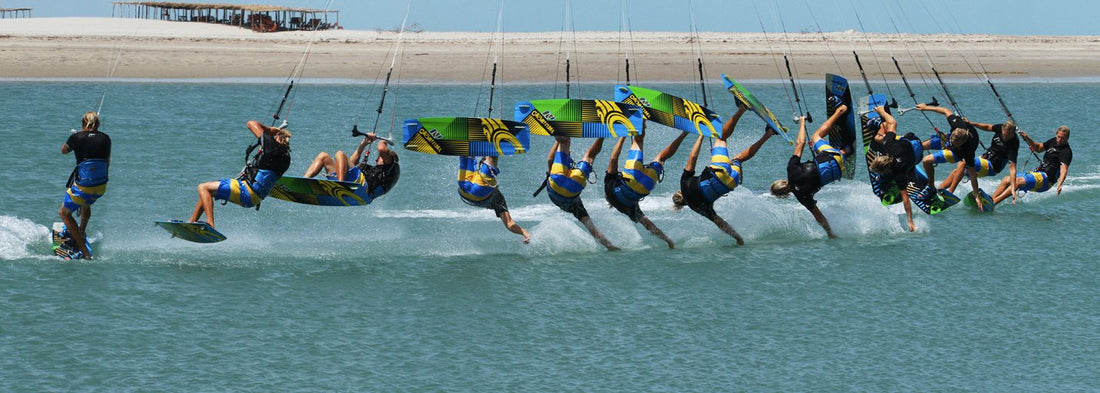
Tricks or Treat #1: Low Front Roll Nose Grab Transition
Share
The fist trick is going to be one of my favorite transitions and one that I do not see too often. It’s a smooth way to switch directions, it feels super cool, and most importantly, It looks awesome.
I would classify this as a moderate level of difficulty because it requires a front roll and a late back loop (kite loop). Obviously the rider must be able to perform these two maneuvers before combining them into one maneuver. We reccomend learning the backroll hand drag or dark slide prior too this trick.
Assuming you have that dialed in, lets jump into the trick!
For the low frontroll, nose grab, transition, you want to be powered. It is important to have a decent amount of power in the kite so that it hoovers you above the water for longer and the trick can be performed slower. When underpowered. The maneuver must be done very quickly and looses it’s affect.
Just like in other sliding transitions, such as the dark slide and the bankroll hand-drag transitions, speed is necessary. You want to approach the trick with a moderate amount of speed so that it is possible to travel further above the water. The longer you can hover above the water and the slower you roll, the cooler this trick will look.
Lets talk about the approach and the pop. As mentioned above, you want to approach this trick with speed. It’s also important to keep your gaze forward, on the water, and in the direction of travel. This will help keep your pop small and should also help to slow the rotation down by keeping the head from tucking too fast.
The pop. The pop is very small. So small, it’s like not popping at all. I say this because typically when you pop you have to load the edge. In this trick, the release from the water (pop) happens by lifting the front knee while on the water, tucking the head, and sheeting in. All of these subtle movements force your weight off the back foot and over the front foot. This will allow the surface tension of the water to release and you to hover right above the water.
The pop and the initial rotation happen all at once. Let me break it down for you.
Legs:
Tuck the front knee BEFORE leaving the water. I like to reach for the grab while I am on the water. This forces my front knee to tuck into the chest aiding in the front roll rotation.
Head:
This is super important. As mentioned before the gaze should be forward, towards the direction of travel. As the trick is initiated, i.e. knee to chest. The head leans forward towards the direction of travel. The lead ear should go down towards the lead shoulder. This will create a more inverted roll. As the ear moves towards the shoulder, the chin will tilt towards the back shoulder. This will assure a good front roll rotation. Hold that position until you spot your landing.
Hands:
The front hand should reach from the nose of the board as soon as the knee begins to tuck. The board should be held by the front hand until the landing is spotted. The back hand is where most of the magic happens. The kite control is crucial to the success of this fancy maneuver. As the board leaves the water the front hand slowly sheets in and progressively holds the bar pressure. If you get too close to the water or fear that you will run into it, you can pull in slightly to provide a bit more lift to keep you from making contact. The position of the bar is held with slow and steady back hand pressure. The back hand should be gradually steering the kite in the opposite direction of travel. As soon as you can spot the landing, and you complete the full rotation, the back hand steers very aggressively to initiate the late back loop. I often let go of the grab when I spot the landing and use my front hand to assist the backhand in finishing the loop (fishing pole) on the bar.
Kite:
As you build speed to approach the trick, the kite should be at a 45. As you are preparing for the pop, the kite should be rising up from a 45 to about a 60 degree angle. I typically will leave the water with the kite around 60-70 degrees and then slowly steer it back. Leaving the water before the kite gets to 12 provides more forward momentum and a bit of lift at the crucial part of this trick. Keeping you inches above the water, traveling forward. The kite will then continue to travel in the opposite direction (backwards) until you complete the rotation. Once the rotation is complete, the kite should be traveling downwards towards the water. The back hand quickly and aggressively steers the kite into a loop while you land and the kite should be continued to loop until it is facing in the new direction (1.5 loops).
Remember!
When trying this trick for the first time it is recommended that you are powered or slightly underpowered. Focus on getting the rotation right and hovering above the water before you focus on looping the kite. I think its best to land then trick, then loop the kite. As you become more confident, you can start looping the kite earlier which will carry you out of the trick with more speed. A word of caution / bonus, if you loop the kite too early, it will turn into a front roll kite loop and there will be a lot of power behind the trick. This is also a very fun maneuver but I would highly reccomend against starting there. It’s quite painful when it doesn’t work out.
A quick step by step is as follows.
Ride fast
Kite slowly rises to 12 from a 45 degree angle.
Before kite approaches 12, keep your gaze on the water and forward.
Tuck the knee, Ear to front shoulder, chin to back shoulder, Grab the nose.
Sheet in the bar hold steady, steer kite back slightly.
Spot landing, steer hard, land, loop kite until its pulling in new direction.
Ride away and scream with excitement!!!! You just dialed in a new, unique transition!
